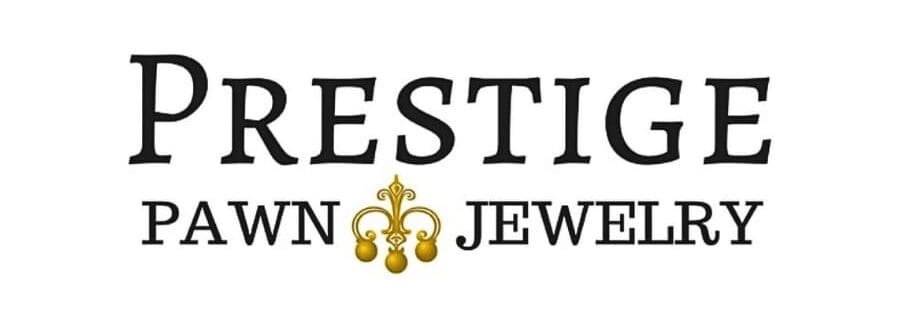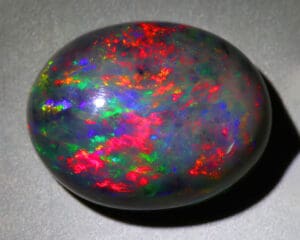Ever held a small, shiny stone and felt the world condensed in your palm? That’s the thrill of encountering rare gems and their values. Like whispered secrets from Earth’s core, they dazzle us with stories told through colors more vibrant than a painter’s palette.
A pink diamond weighing less than an ounce can cost more than your dream house. Why is that?
Perhaps you’ve gazed at the luminescence of pearl jewelry or been entranced by the deep blue-violet hues of a Kashmir sapphire. Or maybe it’s the fiery allure of Burma ruby that captures your imagination?
In this journey into rare gemstones, we’ll unlock these wonders together. You’re about to discover why some stones command astronomical prices while others are simply admired for their beauty.
The world beneath our feet holds treasures beyond compare – ready to dive in?
Table of Contents:
- The World of Colored Diamonds
- Unveiling the Natural Pearl
- The Enigmatic Black Opal
- The Captivating Red Beryl
- The Exquisite Emerald
- Precious Gems: Kashmir Sapphire and Burma Ruby
- Exploring Other Rare Gemstones
- FAQs in Relation to Rare Gems and Their Values
- Conclusion
The World of Colored Diamonds
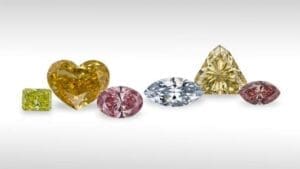
Colored diamonds are a vibrant departure from the classic clear stone. Their allure lies in their rarity and captivating hues, each carrying its own unique story. Blue, pink, or red – these aren’t just colors but symbols of status and wealth.
Diving into the Depths of Blue Diamonds
The mystique surrounding blue diamonds stem from their unusual coloration. A product of boron impurities trapped during formation gives them an alluring deep-blue hue. They’re so rare that they make up less than 0.02% of mined diamonds.
An example is the famed Blue Moon Diamond, valued at $3.93 million per carat. This remarkable gemstone demonstrates how scarcity can skyrocket value.
The Allure of Pink Diamonds
Pink diamonds are yet another treasure among colored gems, admired for their intensity and variation in shades – ranging from faint to vivid pink.
If you thought diamonds were only clear or blue-toned gems used for engagement rings and fancy jewelry, think again. Enter: The Pink Star diamond – another jewel that stands tall among expensive gemstones due to its distinct pink hue and mesmerizing brilliance.
Selling for $71.2 million, this breathtaking Pink Star Diamond, weighing over 59 carats, valued at a record-breaking auction price at Sotheby’s Auction in Hong Kong. It’s like spotting a flamingo dancing amidst swans; absolutely enchanting.
Whether you’re an enthusiast, collector, or potential seller – understanding the inherent value of these gemstones is key. Just remember, with colored diamonds, every color tells a story.
In essence, what sets colored diamonds apart isn’t just their stunning hues but also their uniqueness with every single piece offering something different – be it color tone or clarity grades which only adds more intrigue to these beautiful rarities.
Unveiling the Natural Pearl
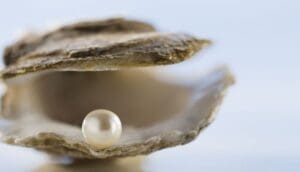
Natural pearls are fascinating gifts from nature, each one unique and brimming with its own tale. Their formation process is a miraculous event that takes place deep within mollusks in oceans, rivers, or lakes.
Formation and Types of Natural Pearls
A natural pearl begins its journey when an irritant accidentally enters a mollusk’s shell. In response to this unwelcome guest, the creature secretes nacre around it as protection – layer upon lustrous layer. Over time these layers coalesce into what we treasure as a natural pearl.
The type of mollusk involved largely influences the resulting color and shape of these beautiful orbs. Saltwater pearls often have round shapes while freshwater counterparts tend to be more irregularly shaped.
Pearl jewelry offers a classic elegance that never goes out of style because every single piece carries traces of history hidden beneath their iridescent surfaces.
Did you know? The most expensive pearl necklace ever sold at auction fetched over $9 million. Now that’s some serious value for something so small yet undeniably exquisite. So next time you spot pearl jewelry on someone’s neck or wrist, remember there’s more than meets the eye – behind those luminous spheres lie stories woven by nature herself.
Note: Always make sure your ‘natural’ pearls are indeed genuine since many pieces on today’s market are actually cultured or imitation versions.
The Enigmatic Black Opal
Imagine a stone that captures the beauty of the cosmos, stars scattered across a dark sky. That’s what it feels like to hold a black opal. The deep hues and shifting colors give this gemstone an enigmatic allure that has captivated jewel enthusiasts worldwide.
Originating from Lightning Ridge in Australia, these opals are treasured for their distinctive play-of-color against a dark body tone, which can range from shades of blue to green or even reds. Each Black Opal is unique with its own individual color pattern and depth.
A single glance at the most valuable black opal in existence – ‘The Royal One’, worth $3 million – is enough to understand why they’re so highly prized by collectors around the globe.
Mysteries Beneath the Surface: Formation Process
In terms of formation process, these rare beauties come into being when silica-rich water seeps into crevices within rocks under specific geological conditions over millions of years. Over time, spheres of silica settle down layer upon layer forming precious opals beneath the earth’s surface.
Vivid Spectrum: Colors Of a Black Opal
No two black opals are identical – each one displays its own magical blend of vibrant colors set against darkness creating an enchanting visual spectacle. This phenomenon known as ‘play-of-color’ makes them sought after additions to jewelry collections or simply mesmerizing stand-alone pieces admired for their ethereal beauty.
Demand In the Market: Rarity and Value
Rarity significantly drives up value; hence due to scarcity and unmatched aesthetic appeal, black opals often command higher prices in the gemstone market. Their value is also determined by their size, color range and pattern along with the degree of brightness.
Next time you’re marveling at a piece of jewelry adorned with this rare gem, remember that it’s not just an accessory but a tiny fragment of our universe encapsulated within.
Key Takeaway:
Black opals, hailing from Lightning Ridge in Australia, are like miniature universes held in your hand. Each one’s unique play-of-color set against dark tones creates a mesmerizing spectacle that fetches high prices due to its rarity and beauty. So next time you spot this gem adorning jewelry, understand it’s more than just an accessory—it’s a captivating slice of the cosmos.
The Captivating Red Beryl
When it comes to gemstones, the red beryl stands out. Its captivating hues and scarcity make it a precious find for collectors and enthusiasts alike.
Originating from volcanic sites in Utah, this vibrant gem is often compared to rubies because of its fiery red color. But don’t let that fool you; red beryl’s are significantly rarer than their ruby counterparts.
You see, while rubies can be found across multiple continents, the occurrence of red beryl’s is limited to specific regions within Utah’s Wah Wah Mountains.
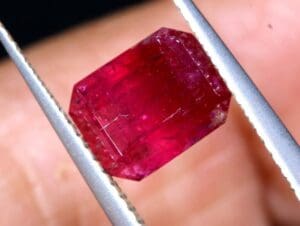
A Closer Look at Red Beryl Formation
Beneath Earth’s crust lies an incredible process. High temperature and pressure conditions allow rare elements like bertrandite to mix with gases such as steam. This combination leads towards creating what we know as the strikingly beautiful – Red Beryl.
This complex formation process makes these gems not just unique but extremely rare too. In fact, they’re said to be 1,000 times scarcer than diamonds.
Understanding Value: Rarity Meets Beauty
The rarity of these stones contributes greatly towards their high value on marketplaces worldwide – but there’s more. The aesthetic allure also plays a significant role in determining their worth.
In essence, the true charm lies in its intense hue which resembles fine wine or ripe raspberries coupled with impressive clarity levels.
- In terms of pricing, the average price per carat for red beryl is $10,000. Quite the investment.
- The largest red beryl ever discovered weighed a whopping 8 carats. That’s approximately equivalent to the weight of two nickels.
Red Beryl’s are truly a sight to behold. Their vibrant color, fascinating origins, and undeniable rarity make them an absolute gem in every sense of the word.
Key Takeaway:
The mesmerizing red beryl, hailing from Utah’s volcanic sites, is a gem collector’s dream with its ruby-like color and rare occurrence. Its formation under high temperatures and pressure results in striking beauty that contributes to its hefty price tag – $10,000 per carat. This gemstone boasts an intense hue resembling fine wine or ripe raspberries along with impressive clarity levels which further amplify its allure.
The Exquisite Emerald
Emeralds, the gemstones symbolizing rebirth and love, have fascinated humanity for centuries. Known for their vibrant green tones, these precious gems originate from deep within Earth’s crust under extreme heat and pressure.
Geographically speaking, most high-quality emeralds are found in Colombia. However, other regions like Zambia also produce valuable specimens with exotic green hues. The presence of chromium and vanadium gives emeralds their iconic coloration – a mesmerizing palette ranging from translucent olive to rich forest greens.
A defining feature of an emerald is its inclusions or ‘jardin,’ French for garden. Unlike diamonds where clarity is king, these minor imperfections don’t diminish an emerald’s value but rather add character and uniqueness to each stone.
An example of this charm can be seen in The Rockefeller Emerald. This 18-carat gem boasts exceptional quality coupled with intense color saturation which fetched it a whopping $305,000 per carat at Christie’s auction.
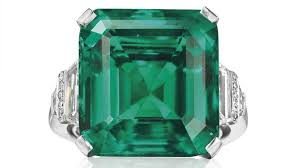
Evaluating Emeralds: A Guide
So how do we gauge the worth of an emerald? Like many gemstones rarer than diamonds such as pink star diamond or musgravite stones from Sri Lanka’s Musgrave region; three main factors come into play – Color, Cut, and Clarity along with Carat weight (popularly known as “the four Cs”).
- Color: In case of emeralds, the deeper the green, the more desirable the stone. Most sought after are those bearing bluish undertones alongside their dominant green hue.
- Cut: A good cut enhances the stone’s color and conceals inclusions. A popular choice is ’emerald cut’ – a rectangular shape with beveled corners, which showcases the gem’s vibrancy.
- Clarity: As mentioned earlier, ‘jardin’ or minor imperfections are not a big deal for emeralds. In fact, some aficionados find these unique traits appealing because they give each gem its own personality.
Key Takeaway:
Emeralds, symbolizing rebirth and love, are precious gems with unique character. Originating mostly from Colombia but also Zambia, their green hues come from chromium and vanadium. Inclusions or ‘jardin’ add uniqueness to each stone rather than diminish its value – like the $305K per carat Rockefeller Emerald. Determining an emerald’s worth is a fascinating process that requires careful consideration of these elements.
Precious Gems: Kashmir Sapphire and Burma Ruby
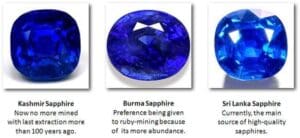
Renowned for their vibrant colors, the Kashmir sapphire and Burma ruby are some of the world’s most valuable gemstones. Both originating from regions with a rich history in gemstone mining, they carry unique stories embedded within their stunning hues.
The Rich Blue of the Kashmir Sapphire
The valleys of northern India, specifically Jammu and Kashmir, offer us one such marvel – the exquisite deep blue-violet colored Kashmir sapphires. These gems exhibit an intense color due to minor imperfections that scatter light inside them. The result is a pure velvety blue that seems almost lit from within.
Kashmir sapphires are also highly prized because they’re incredibly rare. Most were mined out over 100 years ago making current specimens often come from private collections or antique jewelry pieces.
With scarcity comes value – on average these beauties can fetch between $450-$1,600 per carat.
The Deep Red of Burma Ruby

In contrast to the cool blues of its Indian counterpart, we have Burmese rubies hailing from Myanmar’s famed Mogok region whose soil gives birth to stones radiating deep red hues. They get this vividness through traces of chromium which imbues them with an unmatched fiery red glow called “Pigeon’s Blood”. Their incredible hue paired with exceptional clarity make them extremely desirable in fine jewelry.
The Burma ruby’s rarity rivals that of the Kashmir sapphire. High-quality rubies from this region are extremely rare and their market reflects this scarcity, with an average price per carat being a whopping $4,625.
Both these gems embody incredible natural beauty, historical significance, and extraordinary value. But remember – buying such valuable gemstones requires due diligence to ensure authenticity. Always seek help from certified gemologists when making such investments.
Key Takeaway:
Both the Kashmir sapphire and Burma ruby, prized for their intense colors and rich history, are among the world’s most valuable gems. The rarity of these stones significantly boosts their value; a Kashmir sapphire fetches between $450-$1,600 per carat while a high-quality Burma ruby averages at an impressive $4,625 per carat. But it’s not just about the price tag—these gems dazzle with beauty that is simply unmatched.
Exploring Other Rare Gemstones
When it comes to valuable gemstones, musgravite often steals the show. This greyish purple stone, originating from Sri Lanka and the Musgrave region in Australia, is incredibly rare. In fact, its rarity has driven up its value to a staggering $35,000 per carat.
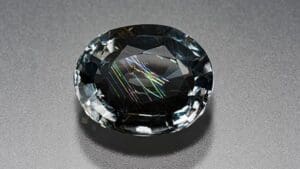
Musgravite stones are known for their deep coloration and minor imperfections that make each piece unique. They’re truly one of nature’s most captivating creations – akin to a painter mixing colors on his palette with an uncanny precision.
Beyond these precious gems exist more members of this exclusive club worth mentioning. Paraiba tourmaline hailing from Brazil enchants with exotic green tones while red diamonds stun observers with vibrant red hues not commonly seen in natural stones.
Rare Burmese rubies emanate an intense shade of red which combined with their scarcity makes them extremely desirable as well as pricey pieces among collectors around the world just like Kashmir sapphires famous for their velvety deep blue-violet tone evoke poet Rumi’s verses about sapphire skies full of spiritual secrets.
It’s safe to say, these rare gemstones are nature’s way of showing off its artistry. From the pink star diamond to musgravite stones and Paraiba tourmaline, they capture our fascination with their uniqueness.
Each piece tells a different story, capturing the essence of geological formations over millions of years. These stunning gemstones are indeed unique and beautiful, which explains their high demand and commanding prices in the market.
Key Takeaway:
These colored gem treasures are more than just beautiful; they’re a glimpse into the heart of our planet. They capture nature’s power, its beauty, and its enduring mystery all at once. The vibrant colors and stunning structures found within these rare gems truly highlight the marvels of Mother Nature.
FAQs in Relation to Rare Gems and Their Values
What is the most rare and valuable gem?
The Pink Star Diamond holds this honor. It fetched a staggering $71.2 million at auction, making it the priciest gem ever sold.
Which gemstone has the most value?
Blue diamonds are among the highest valued gems due to their scarcity and stunning color, with some pieces fetching millions per carat.
What are the 4 precious gemstones?
The five traditionally recognized precious stones are diamond, ruby, sapphire, and emerald–all cherished for their rarity and beauty.
What is my rarest gem?
To accurately determine your stone’s rarity and worth you’ll need an appraisal from a certified jeweler or professional appraiser who can examine its qualities in detail.
Conclusion
Unveiling the world of rare gems and their values, we’ve journeyed through colored diamonds’ brilliance, discovered natural pearls’ allure, and felt black opals’ enigma.
We marveled at red beryl’s vibrant hues. We admired emeralds for their exotic green tones. Kashmir sapphires stole our breath with deep blue-violet colors while Burma rubies ignited our hearts with fiery reds.
Remember this: Each gemstone holds a unique tale from Earth’s heart to your hand. They’re not just valuable because they are rare or beautiful – but also because each carries an ancient story etched in its facets by time itself.
In the end, it isn’t only about owning these precious stones; it’s about cherishing them as pieces of art carved by nature herself.
Sources: https://www.gia.edu/gia-news-research/australia-lightning-ridge-world-capital-fine-black-opal
https://www.christies.com/en/stories/the-rockefeller-emerald-ba425b6764fb46dda7b5eed222bbf56b
